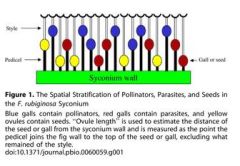Grade Level(s):
- 13-16
Source:
- UC Museum of Paleontology
Resource type:
- Annotated journal article
Time: 1 hour
Overview
Students read a 2008 paper on the role of parasites in stabilizing the fig-pollinator mutualism alongside an interactive guide that explains each section of the paper and draws the reader's attention to important points in the article.

- [Mechanisms of evolution: Grades 13-16] Evolution results from natural selection acting upon genetic variation within a population.
- [Mechanisms of evolution: Grades 13-16] Inherited characteristics affect the likelihood of an organism's survival and reproduction.
- [Mechanisms of evolution: Grades 13-16] The number of offspring that survive to reproduce successfully is limited by environmental factors.
- [Nature of science: Grades 13-16] Scientific knowledge is open to question and revision as we come up with new ideas and discover new evidence.
- [Nature of science: Grades 13-16] A hallmark of science is exposing ideas to testing.
- [Nature of science: Grades 13-16] Scientists test their ideas using multiple lines of evidence.
- [Nature of science: Grades 13-16] Scientists use multiple research methods (experiments, observational research, comparative research, and modeling) to collect data.
- [Nature of science: Grades 13-16] Scientists can test ideas about events and processes long past, very distant, and not directly observable.
- [Nature of science: Grades 13-16] Scientists may explore many different hypotheses to explain their observations.
- [Nature of science: Grades 13-16] Scientific findings and evidence inspire new questions and shape the directions of future scientific research.
- [Nature of science: Grades 13-16] Science is a human endeavor.
- [Studying evolution: Grades 13-16] Our knowledge of the evolution of living things is always being refined as we gather more evidence.
There are no NGSS/DCI concepts currently linked to this resource.
This article works best as part of an extended engagement with the primary literature. To see how to use this article as part of an undergraduate journal club or discussion section, visit The Journal Club Toolkit.
